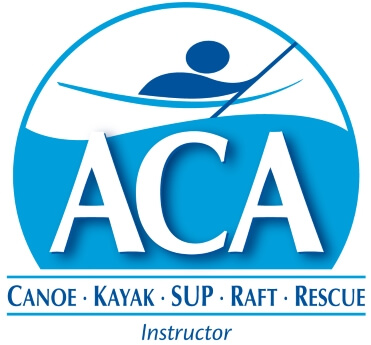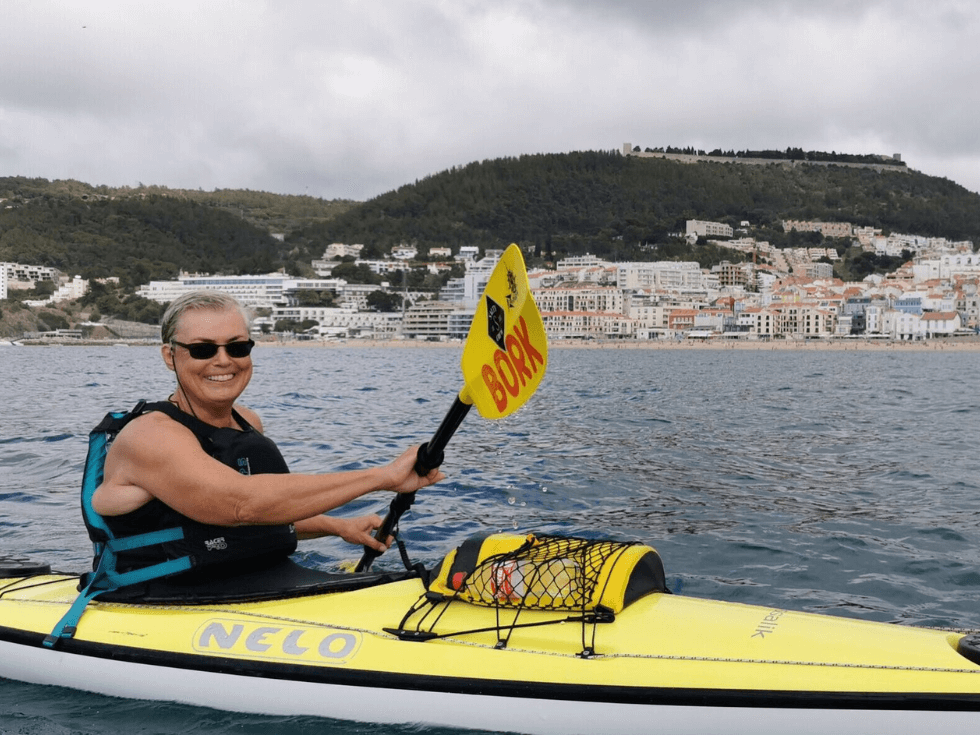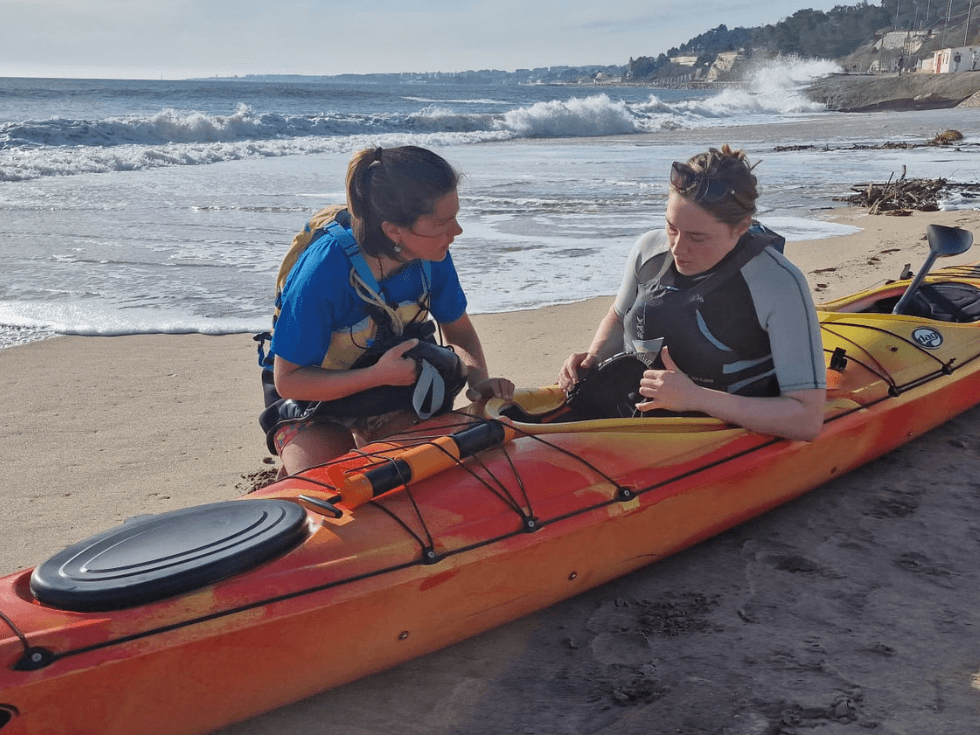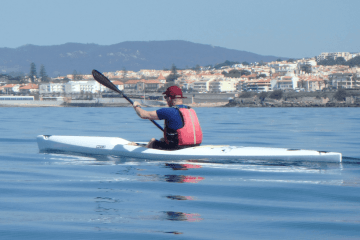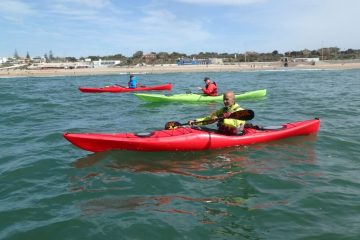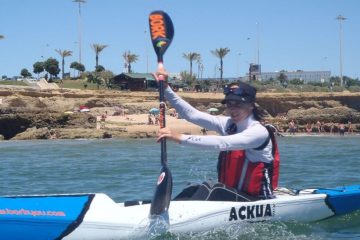all year
Dates
2h / Session, 5 Sessions
Duration
Oeiras Harbour
Location
Introduction to Kayaking Course – ACA (American Canoe Association)
We are the only Portuguese organization to be certified by the American Canoe Association and here you can take the Introduction to Kayaking Level 1 course. The introduction to the course is designed as a short program emphasizing safety, enjoyment, and skill acquisition for entry-level individuals in public, private, and commercial settings.
You’ll learn the fundamentals of kayaking, from paddling corrections to maneuvers and rescue techniques, and you’ll be able to achieve a worldwide recognized certificate. Our instructors are certified by the ACA to teach all the contents of the Sea Kayak Courses.
The course consists of 6 modules which you can access in the contents tab to see more detailed information. If you want to be certified by the ACA, you need to take a practical exam where you must complete the minimum requirements to pass and obtain certification.
This is the beginning of many adventures that await you. You’ll surely be ready to join various expeditions inside and outside Portugal (including ours!) and ready to paddle between rivers and seas with magnificent landscapes.
Getting started
Initially, if you want to experience sea kayaking, you can also take a lesson.
Prices
| SKILLS + ASSESSMENTS | 420€ |
| SKILLS* | 300€ |
| ASSESSMENTS | 180€ |
| LESSON | 75€ |
*You can take the course with just the skills, but if you want certification afterwards it will cost extra.
| DEPARTURE/RETURN LOCATION | BORK Store, Oeiras Marina |
| DEPARTURE TIME | Please arrive 10 minutes before session start. |
| RETURN TIME | Approximately 3 hours/ session. |
| WEAR | Bring a swimming suit, hat and sunscreen. |
Essentials of kayak touring
The course is certified by the American Canoe Association and given by certified instructors who will teach you the basics of coastal kayaking so that you can go further.
We run complete workshops all year long as we have a mild climate.
You might also want to improve specific skills before you take the examination. Here’s the course overview.
The main skills you will learn are the following:
- Introduction, Expectations, and Logistics:
Welcome, introductions, paperwork;
Student and instructor course expectations and limitations;
Course itinerary and site logistics;
Review waiver, assumption of risk, challenge by choice, medical disclosure;
About the ACA.
- Preparing to Depart:
Discuss weather conditions, forecasts, and other environmental hazards (wind, water, weather, waves);
Evaluate hazards to navigation;
Discuss importance of developing good judgment and group responsibility for a trip;
Evaluate individual’s ability, water comfort, and confidence prior to trip;
Warm up to reduce injury;
Make sure the boat is securely fastened to the car or racks, using proper tie downs, straps, or knots;
Review proper techniques to safely lift and carry the kayak on shore;
Review life jackets appropriate for the operator’s size, kayak, and activity, assuring all others in the group are properly wearing their life jacket;
Inspect the kayak and all safety equipment to meet state, federal, and local requirements for the vessel and activity;
Describe and follow safe boating practices (behavior, substance abuse, on water and land etiquette, leave no trace ethics);
Review elements of a float plan (Who, What, When, Where, filing practices);
Review personal equipment needed for the kayak, activity and environment;
Prepare kayak for departure: stowing gear securely, and ensuring it is balanced;
How to hold the paddle in correct orientation and grip for effective paddling.
- Maneuvers: to be performed with appropriate and efficient strokes, while maintaining the trim and
balance of the craft
Enter and launch kayak from shore in a controlled manner, checking for clear departure;
Propel the kayak forward in a straight line 15-20 boat lengths;
Stop the kayak within two boat lengths;
Move the kayak backwards 3-4 boat lengths;
Turn the kayak from a stationary position 180° to the right and left;
Move the kayak sideways 10 feet (3 meters) to each side;
Propel the kayak in a figure of 8 course around markers 3-4 boat lengths apart;
Turn the kayak while maintaining forward motion 90° to the right and left;
Arrive at destination point, checking for clear approach, and exit the kayak in a controlled and safe manner.
- Technical Knowledge:
Review paddling equipment, terminology (kayak and paddle), and care of gear;
Instructor review of additional personal and group gear, including, but not limited to:
○ Environmental supplies (food, water, appropriate clothing, sunscreen, etc.);
○ Navigational and signaling tools (maps, charts, whistle, etc.);
○ Safety and rescue tools;
○ Repair kit;
○ First aid kit (appropriate to training);
Review the dangers of paddle sports and how to plan an appropriate course to avoid potential hazardous situations;
How to avoid and prevent cold water shock, hypothermia and hyperthermia by choosing proper clothing; recognizing and treating early symptoms; 1-10-1 rule;
Recognize the importance of hydration;
Recognize and appropriately use communication (paddle/oar and whistle) signals;
Review basic navigational rules for inland waterways;
Develop awareness of the group and effective on water management techniques;
Describe best paddling practices: posture, balance, awareness of body-kayak-blade relationship;
Secure the kayak and equipment before leaving unattended, with attention paid to environment and conditions.
- Safety and Rescue
Demonstrate awareness of rescue priorities: people, kayak, paddle, gear;
Use safe progressions T-RETHROG (Talk, Reach, THrow, ROw, Go) – including throwable floating aid or throw bag use;
Describe the responsibilities of: the group, rescuer, swimmers;
Identify and demonstrate the use of appropriate rescue and safety gear for the craft and planned activity;
Exit the craft after capsize, using proper body position and contact with the craft and paddle;
Rescue self and the kayak using an effective self rescue technique (e.g., swim self and boat to shore, or deep water reentry);
Rescue a person in the water and capsized kayak using appropriate techniques and equipment for the craft (bailers, pumps, paddle floats, tow lines, etc);
Perform assisted rescues: boat over boat or side by side or T-rescue or others appropriate to conditions;
Perform assisted re-entry: heel hook or rescue sling or /paddle floats or others appropriate to conditions;
Techniques for bulldozing or towing a kayak or swimmer to shore. - Conclusion and Wrap Up:
Group debrief or individual feedback;
Course limitations;
Importance of First Aid and CPR;
Importance of additional instruction, practice, experience;
Importance of appropriate level of safety and rescue training;
Demo advanced maneuver;
Life sport and paddling options;
Local paddling groups and clubs;
Handouts and reference materials;
ACA membership forms;
Course evaluation and participation cards.

